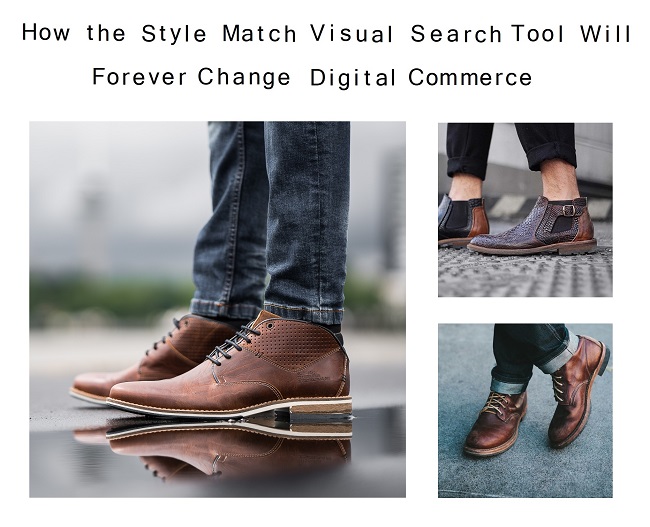Times are changing — that’s a fact. Artificial intelligence (AI) is the driving force behind many of those changes — that’s another fact. Case in point, machine learning and the way it’s changing online search. First, there was text-based search; it was good, it was reliable, it was easy. Then came the mobile revolution and the emergence AI-powered assistants like Siri that opened the avenue for voice search. Easier and more intuitive than text, we quickly adopted it as our go-to search method when we were out and about.
Key in the statement above is intuitive. Talking is one of the first things we learn after birth, and searching with our voices is as intuitive as we can get. Well, search continued evolving — becoming more natural, which is how we arrive at visual search, a way of searching that turns an image into a discovery tool.
Visual Search 2018: How Digital Commerce Is Changing
True to its name, visual search lets us conduct searches with an image as the input. For the marketers out there, you heard that right — visual search SEO is now a thing, so get in touch with a digital marketing agency and set up some custom web development services to catch those visual searchers. Anyway, visual search is completely changing commerce by virtue of allowing users to find what they want with more precision than ever before. After all, what’s a more precise method of searching for a product you like, a couple of keywords or an exact image of what you have in mind? Exactly. Because of this, visual search has the potential to match preferences with products much faster than previous search methods. This, in turn, will make shoppers much happier than ever before, and the brands who offer such capabilities richer.
Brands in the Visual Search Game
And now we move to brands who are already in the visual search game, AKA some cool image search use cases to whet our appetites. Starting with the obvious, Google was one of the first to make the visual search artificial intelligence connection. Even though they’ve had an image search feature for years, today we’ll be talking about Google Lens, a nifty device introduced at Google I/O 2017. Imagine seeing a beautiful flower and being able to know what type of flower it is. Now imagine walking by a restaurant, smelling something delicious coming out of it, and knowing everything you need to know about it — its reviews, its dishes, everything. That’s what Google Lens does; it gives us the ability to identify things around us and presents relevant search results and information about them.
Google is not alone; they may have come first, but other visual search companies have since emerged. For instance, Lens, a Pinterest visual search tool we can all make use of. By using the camera inside the Pinterest app, users can now use the world around them as inspiration for how they style themselves. As they wrote on their announcement:
Just point Lens at a pair of shoes, then tap to see related styles or even ideas for what else to wear them with. Or try it on a table to find similar designs, and even other furniture from the same era. You can also use Lens with food. Just point it at broccoli or a pomegranate to see what recipes come up. Patterns and colors can also lead you in fun, interesting or even just plain weird new directions.
One more before we move onto the crux of the matter today: eBay. eBay has two different AI-powered search tools that allow shoppers to find products they want with images. The first, Image Search, lets users take or upload a picture of something they like, and eBay will provide listings of similar items. The second feature, Find It on eBay, is slightly different in that it requires the social URL of said item, but after that the results are the same.
Asos and Style Match
Now that we’ve covered the other guys, it’s time to focus on Asos. If you’re into fashion, you undoubtedly recognize the Asos brand. If you’re not, it doesn’t really matter — suffice to say that it’s one of the biggest names in fashion eCommerce today. Keeping true to that title, Asos has been making headlines recently by making its global users VERY HAPPY. How? By launching a very useful and cool new feature for shoppers called Style Match. If you’re in the UK, you’re probably already familiar with the feature, as the UK launch was last year; for the rest of us, this is all brand new and very awesome.
With AI and machine learning backing it up, Style Match takes an image as the input and returns items that look like it. For example, let’s say you’re wearing an oversized sweater and love it so much that you decide you want similar styles. No problem. You pull out your phone, open the Asos app, snap a picture, and are presented with more of what you love.
At this point, you may be wondering what makes Style Match different than the other brands with visual search we’ve talked about today. Well, in an age of influencers and fashion bloggers, Asos decided to make the most of it by allowing us to emulate their style at a price we can afford. The kicker comes from the fact that, unlike other apps or brands that use reverse image search technology, Asos’ Style Match presents items from its own catalogue. This means that instead of presenting us with Bella Hadid’s exact Coachella outfit, we’re shown similar styles from Asos’ much more affordable catalogue that comes with over 85,000 products. You also have 10 different filters at your disposal to narrow your search until you find the perfect match: size, brand, gender, product type, style, dress type, range, fit, length and price.
This, that you’re presented with their own items, is what separates Asos from the rest, and why digital commerce is about to change forever. From here, all we can do is wait and see who’s the next to join Asos in the the visual search world.
Final Thoughts with a Quick Recap
It’s fair to say that artificial intelligence (AI) is completely changing the joint marketing and advertising world. In fact, Gartner predicts that by 2021, early adopter brands that redesign their websites to support visual and voice search will increase digital commerce revenue by 30%. Taking this into consideration, and the fact that 80% of their web visits come from mobile devices, Asos released Style Match for their global audience so that they can get the styles they love at a price they can afford.





Tell us your thoughts in the comments